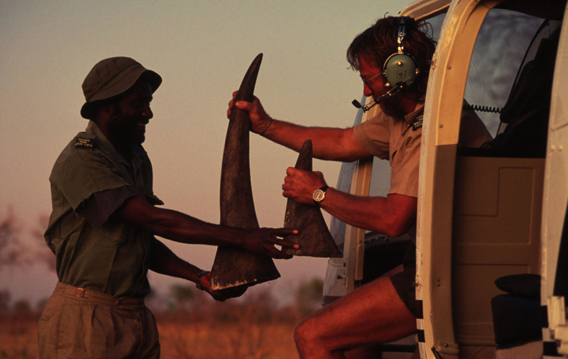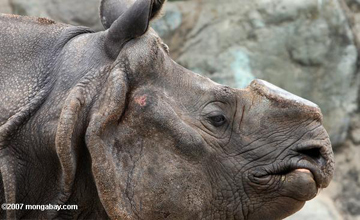Jeremy Hance mongabay.com May 11, 2011 WARNING: Graphic photos below.  Recently cut white rhino horns in Zimbabwe. Photos: © Michel Gunther / WWF-Canon.
"There is no medicinal benefit to consuming rhino horn. It has been extensively analyzed in separate studies, by different institutions, and rhino horn was found to contain no medical properties whatsoever," says Rhishja Larson, creator and head of the organization Saving Rhinos and author of the blog, Rhino Horn is NOT Medicine.
"Until we acknowledge the root of the problem, we cannot take real steps to solve it. There is still a large segment of the public—including the media—that does not realize we are looking at an organized crime issue. […] Here's an illegal market laundering an obscene amount of money—and it's all based on a myth, a superstition about an animal part," Larson explains, adding that, "I believe if the public knew the whole story, there would be a greater effort to disrupt—and ultimately close down—the rhino horn trade." According to Larson, rhino poaching, and the illegal wildlife trade in general, is not taken seriously enough. "Exactly like illegal drugs and weapons, the illegal rhino horn trade depends on activities such as fraud, money laundering, racketeering, and violence. It requires the involvement of corrupt officials at the local, national, and international levels." South Africa has become the recent epicenter for rhino poaching. Last year 333 rhinos were butchered in the country alone. This year, to date, over 140 rhinos have been killed in the country. Larson says South Africa is targeted in part because it holds over two thirds of the world's rhinos, but, she adds, "the bigger issue here is South Africa's legal rhino trade, which is providing a smokescreen for illegal trade in rhino horn." Trophy hunters are allowed to kill a rhino for a premium price; however, this has allowed poachers in some cases to kill rhinos without attracting attention to their true motives. Rhino poaching, along with rampant deforestation, have put three of five rhino species into the Critically Endangered category, the worst before extinction. In fact, the Javan rhino and the Sumatran are two of the world's most endangered mammals. It is thought the last Javan Rhino surviving in Vietnam (there are still a few dozen in Java) was killed by poachers last year.
"We need to publicize the fact that the notion of rhino horn as a medicine is a myth," says Larson. "And by 'we', I mean all of us: NGOs, zoos, traditional media, social media, and the public. I think this needs to be a sustained effort, utilizing every communication channel available, for example, websites, printed materials, educational events, social media. […] It is perhaps equally important to emphasize the organized crime aspect of rhino horn trafficking." For Larson, political-correctness or cultural sensitivity no longer has any room in the debate: "Using helicopters to kill rhinos in South Africa is not about preserving tradition in China or anywhere else. Today's rhino crisis does not represent the cultural interests of the many—it is driven by the commercial interests of a few." In a May 2011 interview Rhishja Larson discussed the current rhino poaching crisis, rising demand in Asia for powdered horn, and how best to combat the organized trade. |
Friday, May 13, 2011
Belief and butchery: how lies and organized crime are pushing rhinos to extinction
Subscribe to:
Post Comments (Atom)


No comments:
Post a Comment